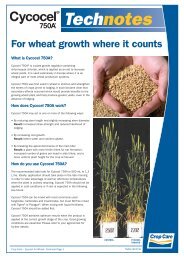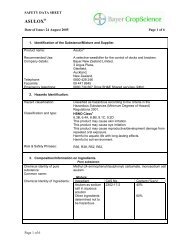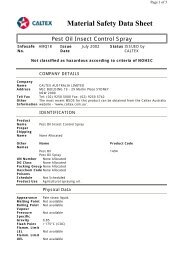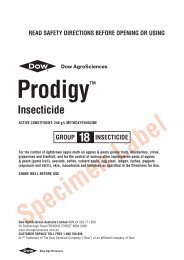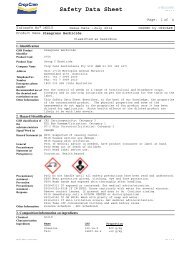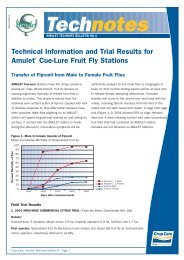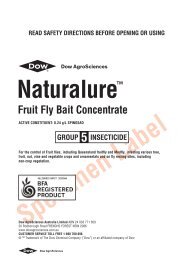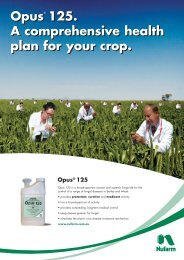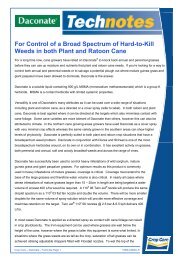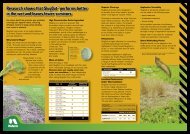Material Safety Data Sheet - Pest Genie
Material Safety Data Sheet - Pest Genie
Material Safety Data Sheet - Pest Genie
Create successful ePaper yourself
Turn your PDF publications into a flip-book with our unique Google optimized e-Paper software.
Page 1 of 5<strong>Material</strong> <strong>Safety</strong> <strong>Data</strong> <strong>Sheet</strong><strong>Pest</strong> OilInfosafeNo.AMQ18IssueDateJuly 2002Status ISSUED byCALTEXNot classified as hazardous according to criteria of NOHSCCOMPANY DETAILSCompanyName CALTEX AUSTRALIA LIMITEDAddress MLC BUILDING 19 - 29 Martin Place SYDNEYNSW 2000Tel/Fax Tel: (02) 9250 5000 Fax: (02) 9250 5742Other The most recent MSDS for this product can be obtained from the Caltex AustraliaInformation website - 'www.caltex.com.au'.IDENTIFICATIONProductCode 1494ProductName <strong>Pest</strong> OilProperShippingName None AllocatedOther NameNames<strong>Pest</strong> Oil Spray<strong>Pest</strong> Oil Insect Control SprayUN Number None AllocatedDG Class None AllocatedPacking Group None AllocatedHazchem Code None AllocatedPoisonsSchedule Not ScheduledProduct Use Agricultural spraying oil.Product CodePhysical <strong>Data</strong>Appearance Pale straw liquid.Melting Point Not availableBoiling Point Not availableVapourPressure Not availableSpecificGravity 0.85Flash Point >175°C (COC)Flamm. LimitLELNot available
Page 2 of 5Flamm. LimitUELSolubility inWaterNot availableEmulsifiableOther PropertiesViscosityStabilityHaz.PolymerizationWill not occur.<strong>Material</strong>s toAvoidNot availableStable under normal conditions of storage and handling.Strong oxidising agents.IngredientsIngredients Name CAS ProportionInformationonCompositionIngredients determinednot to be hazardousNot required100 %Heavy paraffinic distillates and additives which include emulsifiers andstabaliser.HEALTH HAZARD INFORMATIONHealth EffectsAcute -SwallowedAcute - EyeAcute - SkinAcute -InhaledChronicMay cause irritation of the gastrointestinal tract with nausea, vomiting anddiarrhoea if more than several mouthfuls are swallowed. Aspiration of vomitedmaterial can be moderately hazardous.Eye contact may cause mild irritation with stinging, blurring and tearing.May dry and defat the skin, resulting in skin irritation and possible dermatitis.Inhalation of vapours or mists generated in confined, poorly ventilated areas orat elevated temperatures, may cause respiratory system irritation, otherpulmonary effects, headache, dizziness and nausea.Prolonged or repeated contact may result in skin irritation leading todermatitis.First AidSwallowedEyeSkinInhaledFirst AidFacilitiesDO NOT INDUCE VOMITING. Wash out mouth with water and give plenty ofwater to drink. Seek medical attention.If contact with the eye(s) occurs, wash with copious amounts of water holdingeyelid(s) open. Take care not to rinse contaminated water into the non-affectedeye. If symptoms persist seek medical attention.Wash affected area thoroughly with soap and water. If symptoms develop seekmedical attention.Remove the source of contamination or move the victim to fresh air. Ensureairways are clear and have qualified person give oxygen through a face mask ifbreathing is difficult. If symptoms develop seek medical attention.Eye wash and normal wash room facilities.Advice to DoctorAdvice to
Page 3 of 5DoctorTreat symptomatically.Other Health Hazard InformationPRECAUTIONS FOR USEExposureLimitsEng. ControlsNo value assigned for this specific material by the National Occupational Healthand <strong>Safety</strong> Commission (NOHSC). However, Exposure Standards for oil mistare listed below.SUBSTANCE TWA STELppm mg/m³ ppm mg/m³Oil mist, mineral - 5 - 10Where vapours or mists are generated and exposure standards are exceeded,the use of respiratory protection, or a local exhaust ventilation system isrecommended.RespiratorType (AS1716)Personal ProtectionWhere vapours, mists or spray is generated and exposure standards areexceeded, select and use respirators in accordance with AS/NZS 1715/1716.The use of the following is recommended: Approved respirator with organicvapour and dust/mist filters. Filter capacity and respirator type depends onexposure levels for each individual circumstance.Eye Protection If possibility of eye contact exists safety glasses with side shields or gogglesshould be worn as described in Australian Standard AS/ANZ 1337 - EyeProtectors for Industrial Applications.Glove TypeClothingImpervious PVC or rubber gloves should be worn to minimise skin contact.Any routine contact with this material should require the use of protectiveclothing such as an apron made of neoprene, nitrile, or n-butyl rubber suitablefor the application.FlammabilityFire HazardsClassified as a Class C2 (COMBUSTIBLE LIQUID) for the purpose of storage andhandling, in accordance with the requirements of AS1940. This product shouldbe stored and used in a well ventilated area away from naked flames, sparksand other sources of ignition.SAFE HANDLING INFORMATIONStorage and TransportStoragePrecautionsTransportHandlingStore in a cool, dry, well ventilated area away from sources of ignition. Thisproduct should be stored away from foodstuffs and strong oxidising agents.Minimum feasible handling temperatures should be maintained. Periods ofexposure to high temperatures should be minimised. Water contaminationshould be avoided. For information on the design of the store-room referenceshould be made to Australian Standard AS1940- The storage and handling offlammable and combustible liquids. Reference should also be made to anyrelevant Commonwealth, State or Territory regulations.Not classified as a Dangerous Good according to the Australian Code for theTransport of Dangerous Goods by Road and Rail.Repeated or prolonged contact with this material should be avoided in order tolessen the possibility of skin disorders. It is essential that all who come intocontact with this material maintain high standards of personal hygiene ie.washing hands prior to eating, drinking or going to the toilet. Build-up of mists
Page 4 of 5ProperShippingNamein the working atmosphere must be prevented.Misuse of empty containers can be hazardous. Do not cut, weld, heat or drillcontainers. Residue may ignite with explosive violence if heated sufficiently. Donot pressurise or expose to open flame or heat. Keep container closed andbung in place.None AllocatedSpills and DisposalSpills & Leaks Remove sources of ignition. Stop the source of the leak or release and containspill if possible. Ventilate area. Use respirator and protective clothing tominimise exposure. Cover spill with a generous amount of inert absorbent.Collect and place in a labelled disposable container. Scrub contaminated areawith detergent and water using a stiff broom. Pick up liquid with additionalabsorbent and place in a labelled disposable container. Prevent contaminationof groundwater or surface water. This material may present environmentalrisks common to oil spills. If large quantities of this material enter thewaterways contact the Environmental Protection Authority, or your local WasteManagement Authority.Disposal Dispose of waste according to federal, E.P.A., state and local regulations.Assure conformity with all applicable regulations.Fire/Explosion HazardFire/Explos.Hazard Combustible liquid. This product will burn if exposed to fire.HazardousDecompositionor Byproducts Aldehydes and ketones, combustion products of nitrogen, carbon and sulphur.Fire Fighting For fires involving this material, do not enter any enclosed or confined spaceProcedures without AS/NZS 1716 approved Self-contained breathing apparatus (S.C.B.A.)to protect against the hazardous effects of combustion products or oxygenExtinguishingMediaHazchem CodeNone Allocateddeficiency.Use water fog, dry chemical, foam, or carbon dioxide. Water or foam maycause frothing. Use water to cool fire-exposed containers. If a leak or spill hasnot ignited, use water spray to disperse the vapours and to provide protectionfor persons attempting to stop the leak.OTHER INFORMATIONToxicologyEnvironmentProtectionReferencesThe main constituents in this product are in accordance with Note L of theNOHSC Designated List of Hazardous Substances, the manufacturer has hadthe main constituents tested in accordance with IP346 and contain less than3% polyaromatics.This material must not be allowed to enter drains, sewers or waterways.REGULATIONS SPECIFICALLY APPLICABLE TO THE CHEMICAL PRODUCT:COMMONWEALTH OF AUSTRALIA: Respirators must follow AS1715/1716standardfor approved respirators.NEW ZEALAND: Respirators must follow NZS 1715/1716 standard for approvedrespirators.INTERNATIONAL (ALL COUNTRIES): In the absence of local approvedauthorities, follow U.S. NIOSH/MSHA, U.K. BSI, Australian AS1715/1716, orNew Zealand NZS 1715/1716 standards.AUSTRALIA POISON SCHEDULE: Not applicable.
Page 5 of 5NZ DANGEROUS GOODS CLASS: Not applicable.NZ TOXIC SUBSTANCES SCHEDULE: Not applicable.CONTACT POINTContact CHEMICAL EMERGENCIES: 1 800 033 111TECHNICAL ADVICE: 1300 364 169Health & <strong>Safety</strong> AdvisorTel: (02) 9695 3607 or (02) 9250 5900PLEASE NOTE that although every care has been taken in compiling the aboveinformation, it is solely reliant upon data available to us at the date hereof. Webelieve the data to be correct, however for the reason just stated we are not ina position to warrant its accuracy. With that in mind and given that the fullrange of possibilities and conditions under which the information may beapplied simply cannot be anticipated, YOU ARE CAUTIONED to make your owndeterminations as to the veracity and the suitability of the information to theparticular circumstances that apply, or may apply, to you from time to time.Consistent with that approach it is recommended that where you have aparticular purpose which would necessitate a reliance on information of thenature herein you obtain your own independent expert advice particularlystructured to the relevant purpose. If this material is printed, circulated,distributed or copied in any manner, it is not to be modified without priorwritten permission, and further, it is to include the wording of the abovedisclaimer.End of MSDS



